These TS 10th Class Biology Chapter Wise Important Questions 1st Lesson Nutrition will help the students to improve their time and approach.
TS 10th Class Biology Important Questions 1st Lesson Nutrition
1 Mark Questions
Question 1.
What happens if the food we eat is not a balanced diet?
Answer:
1. Food is the main source to maintain biological process in a perfect manner.
2. If the food we eat is not a balanced diet then
- Growth and proper development of the body may not takes place.
- We may get various types of diseases.
Question 2.
Prepare your own tabular column to get information about food deficiency diseases from a doctor.
Answer:
| S.No. | Name of the disease | Symptoms | Deficiency due to which nutrient |
| 1. | Kwashiorkor | Hands and legs swollen, fluffy face, loose motions. | Protein deficiency |
| 2. | Marasmus | Lean, weak, swollen joints, no development in muscles, loose motions. | Both proteins and calories deficiency. |
Question 3.
Why KOH is used in Mohl’s half leaf experiment ?
Answer:
- We conducted Mohl’s half-leaf experiment to prove CO2 is essential for photosynthesis.
- So KOH is used in this experiment to absorb the CO2 present inside the bottle.
![]()
Question 4.
What questions will you ask a doctor to know about malnutrition?
Answer:
- What is malnutrition?
- What are the causes for malnutrition?
- What are the types in malnutrition?
- How can we overcome the malnutrition?
Question 5.
Name the vitamin which is synthesized by the bacteria present in the human intestine.
Answer:
B12 (Cyanocobalamine) is the vitamin which is synthesized by the bacteria present in the human intestine.
Question 6.
Which digestive juice doesn’t contain enzymes?
Answer:
Bile juice which is produced by liver doesn’t contain enzymes. But it converts fats into small globules. This process is called emulsification.
Question 7.
One student takes high caloric food. Another student takes less caloric food. But both are affected with diseases. Name the diseases by which they are affected.
Answer:
Student takes high caloric food affected by – Obesity
Student takes less caloric food affected with – Marasmus.
![]()
Question 8.
Mention the two chemicals which you have used in an experiment to test the presence of starch in the leaf.
Answer:
The chemicals used in an experiment to test the presence of starch in the leaf are
- Methylated spirit
- Iodine solution.
Question 9.
Why do we use KOH solution in Mohi’s half-leaf experiment?
Answer:
KOH absorbs CO2 in the bottle.
Question 10.
Write two slogans for campaign on Malnutrition.
Answer:
- Be cool and say no to fast food.
- Be smart – Eat smart
- Eat healthy – Look healthy – Feel healthy
Question 11.
Identify the two parts A and B indicated in the given figure.
Answer:
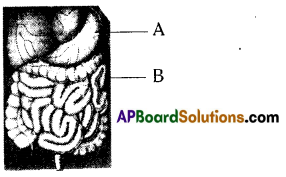
Question 12.
Doctors advise not to eat food items at the time of fever. What are the reasons for this?
Answer:
Doctors advise to take light food during fever. Fried food items are not easily digested as the digestive system cannot digest heavy foods especially meat, fish etc. These fried items are sometimes attributed to excessive strain along the gastrointestinal system.
Question 13.
If we chew the grains like wheat, jowar, rice we feel sweet. Why?
Answer:
When we chew the grains like wheat, jowar and rice we feel sweet because the salivary amylase present in the saliva break complex food particles that is starch into maltose which is a sugar. Hence we feel sweet when we chew grains like wheat, jowar and rice.
![]()
Question 14.
What teeth you use when you eat peas and banana ? Why?
Answer:
Premolars and molars are used when we eat peas awl banana. Their function is to chew and grind the seed and food material.
Question 15.
What is autotrophic nutrition?
Answer:
Autotrophic nutrition is that type of nutrition in which an organism makes its own food from the simple inorganic materials like carbon dioxide and water using light as source of energy.
Question 16.
What is nutrition?
Answer:
Nutrition is the process of intake or procurement of nutrients.
Question 17.
What are the complex molecules produced by plants from simple inorganic substances?
Answer:
Carbohydrates, proteins and lipids are produced (from simple inorganic substances like water and CO2.
Question 18.
What are the essential factors required for photosynthesis?
Answer:
Carbon dioxide, water, chlorophyll and sunlight are the essential factors required for photosynthesis.
Question 19.
Define photosynthesis.
Answer:
Photosynthesis is the process by which all green plants contain the green pigment called chlorophyll which build up complex organic molecules from relatively simple inorganic ones using light as an energy source.
Question 20.
What is the equation for photosynthesis proposed by C.B. Van Neil in the year 1931?
Answer:
![]()
Question 21.
What is the balanced (modified) equation to show the process of photosynthesis?
Answer:
![]()
Question 22.
In which form carbohydrates are stored in plants?
Answer:
Starch.
Question 23.
What is the reagent that is used to test the presence of starch in leaves?
Answer:
Iodine solution. The colour of the leaf will turn to blue-black.
![]()
Question 24.
Who found that water was essential for the increase of plant mass?
Answer:
Von Helinont.
Question 25.
Who performed series of experiments in 1770 to reveal the role of air in growth of green plants?
Answer:
Joseph Priestly.
Question 26.
What is the role of potassium hydroxide solution kept inside the glass bottle in the Mohl’s half-leaf experiment?
Answer:
It absorbs the carbon dioxide present inside the bottle.
Question 27.
Who found that gas bubbles liberated from hydrilla plant contain the gas oxygen?
Answer:
Jan Ingenhousz in 1779 found that the gas present in the bubbles was oxygen.
Question 28.
Who coined the term chlorophyll for the extract of green coloured substance from the leaf?
Answer:
Pelletier and Caventou in the year 1817 coined chlorophyll for the extract of green coloured substence from the leaf.
Question 29.
Luzloroplast is formed by how many membranes?
Answer:
Chloroplast is formed by 3 membranes.
Question 30.
Whatlsgrana?
Answer:
The stacked sack-like structures formed by the third layer of chloroplasts is called grana.
Question 31.
What is stroma?
Answer:
The fluid filled portion of chloroplast is called as stroma.
Question 32.
What is the function of stroma?
Answer:
It is believed to be responsible for enzymatic reactions leading to the synthesis of glucose, which in turn join together to form starch.
![]()
Question 33.
What are the two major phases found in photosynthesis?
Answer:
The two major phases found in photosynthesis are :
- Light reaction and
- Dark reaction.
Question 34.
Why is light reaction phase called photochemical phase?
Answer:
A series of chemical reactions occurs in a very quick succession initiated by light and therefore the phase is technically called the photosynthetic phase.
Question 35.
Where does the light reaction take place?
Answer:
The light reaction takes place in charophyte containing thylakoids called Crana of Chloroplasts.
Question 36.
What are the end products of light reaction?
Answer:
The end products of light reaction are O2 ATP and NADPH.
Question 37.
How glucose is produced during dark reactions?
Answer:
In the dark reaction, the hydrogen of the NADPH is used to combine with CO2 by utilizing ATP energy and ultimately produce glucose.
Question 38.
Write some of the events that occur in the chloroplasts during photosynthesis.
Answer:
- Conversion of light energy to chemical energy.
- Splitting of water molecule.
- Reduction of carbon dioxide to carbohydrates.
Question 39.
What is photolysis of water?
Answer:
Splitting of water molecule by light activated chlorophyll molecules is known as photolysis of water.
Question 40.
What are guard cells?
Answer:
The two kidney-shaped cells which surround the stroma are called guard cells.
Question 41.
How does CO2 enter into leaf?
Answer:
CO2 enters through stomata into the cells of leaf by diffusion.
Question 42.
Why are ATP and NADPH required in photosynthesis?
Answer:
ATP and NADPH are required for the utilization of carbon dioxide and formation of glucose during photosynthesis.
Question 43.
Why are chloroplasts green in colour?
Answer:
Chloroplasts are green in colour due to presence of a green coloured pigment called chlorophyll.
Question 44.
What are the examples for parasitic organisms?
Answer:
Cuscuta (plant), lice, leeches and tapeworms.
Question 45.
What is ingestion?
Answer:
The process of taking food in the body is called ingestion.
![]()
Question 46.
Name the three pairs of salivary glands. What is the enzyme secreted by them?
Answer:
The three pairs of salivary glands in mouth are:
- Parotid glands
- Submandibular glands and
- Sublingual glands.
The enzyme secreted by salivary glands is amylase (ptyalin).
Question 47.
What is the role of amylase in digestion of food?
Answer:
Amylase helps in the breakdown of complex carbohydrates to maltose sugar
Question 48.
What is digestion?
Answer:
The process of breaking down of complex food substances into the simple substances so that they can be used by the body with the help of enzymes is called digestion.
Question 49.
How the food from oesophagus moves into the stomach?
Answer:
Food passes through oesophagus by wave like movements called peristaltic movements and reaches the stomach.
Question 50.
What is chyme?
Answer:
Chyme is a soft slimy substance of food in which some proteins and carbohydrates have broken down.
Question 51.
What is the role of sphincters muscle present at the exit of stomach ?
Answer:
The sphincters are responsible for regulating the opening such that only small quantities of the food material may be passed into the small intestine at a time.
Question 52.
The gastric juice secreted by the walls of stomach contains
Answer:
Hydrochloric acid, protein digesting enzyme, pepsin and mucus.
Question 53.
What makes the internal condition of the Intestine gradually to a basic oralkaline one?
Answer:
Liver and pancreatic juices make the internal condition of the intestine gradually to a basic or alkaline one.
Question 54.
What is emulsification?
Answer:
Fats are digested by converting them into small globule-like forms by the help of bile juice secreted from liver. This process is called emulsification.
Question 55.
What are the enzymes that acts on proteins?
Answer:
Pepsin and trypsin are the enzymes act on proteins.
Question 56.
What is absorption?
Answer:
Transport of the products of digestion from the walls of the intestine into blood is called absorption.
Question 57.
What is defecation?
Answer:
The passage of undigested material excess salts from the body by the way of anus is called defecation.
Question 58.
What are roughages in the food?
Answer:
Roughages are fibres of either carbohydrates and fats.
Question 59.
What are the parts of human digestive system?
Answer:
Mouth, buccal cavity, pharynx, oesophagus, stomach, small intestine, large intestine, rectum and anus.
![]()
Question 60.
What is balanced diet?
Answer:
Diet containing nutrients in required amounts is known as balanced diet.
Question 61.
What are the nutrients present in balanced diet?
Answer:
Carbohydrates, proteins, fats, vitamins and mineral salts.
Question 62.
What is malnutrition?
Answer:
Eating of food that does not have one or more than one nutrients in required amount is known as malnutrition.
Question 63.
What are the two sources of vitamins to our body?
Answer:
One is diet and the other is bacteria present in the intestine synthesis and supply the vitamins.
Question 64.
Into how many groups the vitamins are classified?
Answer:
Vitamins are classified into two groups. They are fat soluble (eg. A, D, E and K) and water soluble (eg: B complex, Vitamin C).
Question 65.
What is the chemical name of vitamin B12?
Answer:
The chemical name of vitamin B12 is Cyanocobalamine.
![]()
Question 66.
Which vitamin deficiency causes sterility in males?
Answer:
Tocoferol deficiency causes sterility in males.
Question 67.
What is the chemical name of vitamin ‘C’ ? Deficiency of vitamin ‘C’ causes which disease?
Answer:
The chemical name of vitamin ‘C’ is Ascorbic acid. Its deficiency causes in Scurvy disease.
Question 68.
What are heterotrophs?
Answer:
The organisms, which cannot prepare their own food from inorganic substances like carbon dioxide and water and depend on other organisms for their food are called heterotrophs. Eg: Animals, Yeast.
Question 69.
What are autotrophs?
Answer:
The organisms, which can make their own food from carbon dioxide and water are called autotrophs. Eg: Green plants.
Question 70.
What was the opinion of C.B. Van Neil on the equation for photosynthesis?
Answer:
For each molecule of carbohydrate formed, one molecule of water and one molecule of oxygen is also produced.
Question 71.
From where do we get energy to do work?
Answer:
We get energy to do work from the food we eat.
Question 72.
In plants gaseous exchange occurs through?
Answer:
Gaseous exchange in plants occurs through the stomata present in leaves and also through loose tissues on stems, roots etc.
Question 73.
From where do the aquatic plants get CO2 to manufacture food?
Answer:
Aquatic plants utilize the carbon dioxide dissolved in water.
![]()
Question 74.
What are the causes for vomiting?
Answer:
Causes for vomiting:
- Overeating especially when the food contain a high proportion of fat or oil.
- When we eat something very indigestible or poisonous.
Question 75.
Why do we feel bilious or liverish?
Answer:
It is the result of having eaten rich meals for several days.
Question 76.
What are the symptoms of disease pellagra?
Answer:
Dermatitis, diarrhoea, loss of memory and scaly skin.
Question 77.
Which vitamin deficiency causes Rickets ? What are Its symptoms?
Answer:
Vitamin D Calciferol deficiency results in Rickets. The symptoms shown are improper formation of bones, knock-knees, swollen wrists, delayed dentition, weak bones etc.
Question 78.
For proper vision which vitamin is required? What is its chemical name?
Answer:
Vitamin A is required for proper vision of eye. It’s chemical name is Retinol.
Question 79.
The leaves of a plant first prepares food A by photosynthesis. Food A then gets converted into food B. What are A and B?
Answer:
Glucose is first prepared by plant through photosynthesis. It gets converted to starch.
![]()
Question 80.
Which substance is used to remove chlorophyll from a green leaf during photosynthesis experiments?
Answer:
Alcohol Methylated spirit.
Question 90.
What is the name of those cells in the leaf of a plant which control the opening and closing of stomata?
Answer:
Guard cells.
Question 91.
What substances enter into the food vacuole in Amoeba to break down the food?
Answer:
Digestive enzymes from cytoplasm enter into the food vacuole to break down the food.
Question 92.
From which part of the body, undigested food is egested in Amoeba?
Answer:
Cell membrane.
Question 93.
Why does raw bread taste sweeter on mastication?
Answer:
It is because salivary glands secrete salivary amylase which converts starch into sugars.
Question 94.
Which wavelength of light is best absorbed by chlorophyll?
Answer:
Red colour wavelength.
Question 95.
What is the function of thylakoid membranes in chloroplast?
Answer:
Thylakoid membranes provide large surface area for light absorption.
2 Mark Questions
Question 1.
What questions do you ask your teacher to know about the obesity and its consequences?
Answer:
- What are the reasons for Obesity?
- How to reduce the body weight?
- What are the consequences of obesity?
- What type of food you suggest to people suffering from obesity?
![]()
Question 2.
Prepare four questions for the Gastro-enterologist to know the problems that occur in the digestive system.
Answer:
- Why do the people suffer from indigestion problems?
- Why do we get vomitings?
- Why do we get belching?
- Why do we get ulcers in stomach?
- What is acidity?
Question 3.
Balance the following equation. Write what you have received through this equation.
![]()
Answer:
![]()
This equation represents the process of photosynthesis. For the photosynthesis to occur, four factors are required. They are carbon dioxide, water, light and chlorophyll. 6 molecules of carbon dioxide and 12 molecules of water in the presence of sunlight and chlorophyll forms 1 molecule of glucose, 6 molecules of water and 6 molecules of oxygen.
Question 4.
Nutrition in auto frophs occurs when there Is light and without light also. What is the difference between these two situations?
Answer:
Some micro-organisms like bacteria are capable of synthesizing their own food in the absence of light. Chemo-autotrophs use inorganic energy sources to synthesize organic compounds from carbon dioxide. These organisms are able to produce their own source of food or energy.
The energy required for this process comes from the oxidation of inorganic molecules such as iron, sulphur or magnesium. Examples : Nitrogen fixing bacteria in the soil, iron oxidising bacteria located in the lava bed, sulphur oxidising bacteria located in deep sea thermal vents.
Question 5.
Pregnant ladies are advised to eat leafy vegetables and take folic acid pills. Why?
Answer:
Folic acid is the part of the B – complex family of vitamins. Dark green leafy vegetables are a good source of folk acid. Folk acid is often prescribed for pregnant women because it is essential for the normal development of the brain and spinal cord of the foetus. It also help in protection against birth defects. It also required for the synthesis of nucleic acids DNA and RNA. Hence pregnant ladies are advised to eat leafy vegetables and take folic acid pills.
![]()
Question 6.
You want to know about intestinal juice from your nearby doctor. Which questions do you ask him?
Answer:
- Which part of the small intestine secrete intestinal juice?
- Intestinal juice contains which enzymes?
- Intestinal juice converts peptides into?
- Sucrose present in intestinal juice converts sucrose to?
- Digestion of which nutrient resumes in small intestine?
- Which digestive juice involved the complete digestion of food?
Question 7.
Photosynthesis process provides food for all organisms. It mainly takes place by two phases. Light reaction is first phase.
H2O → H+OH
Above equation in light reaction shows what?
Answer:
- The first phase of photosynthesis is light reaction. It occurs in grana of chloroplast.
- During this phase light activated chlorophyll molecule splits water molecule into Hydrogen (H+) and Hydroxyl ions (OH–).
- This reaction is known as photolysis which means splitting by light (photo means light, lysis means breaking). This was discovered by Hill. Hence ¡t is also called Hill’s reaction.
Question 8.
Write names of the given sentences.
i. Organelle in which photosynthesis occurs.
ii. Life process in which complex food is converted into simple substances.
iii. The part after large intestine in digestive tract.
iv. Deficiency of Vitamin “K” cousin g disease.
Answer:
i. Chioroplast
ii. Digestive system
iii. Anus
iv. Delay in blood clotting.
Question 9.
Write a brief note on heterotrophic nutrition.
OR
How non-green plants and animals get their food?
Answer:
- Heterotrophic nutrition is that mode of nutrition in which an organism cannot make its own food from simple inorganic materials like CO2 and water and depends on other organism for food.
- All the animals have a heterotrophic mode of nutrition.
- Most bacteria and fungi also have heterotrophic mode of nutrition.
- Heterotrophs are the organisms that depend on others for their food requirement.
- The non-green plants and animals are heterotrophs which depend on plants or other animals for their food.
![]()
Question 10.
Briefly explain about saprophytic nutrition.
Answer:
- Saprophytic nutrition is the nutrition in which an organism obtain its food from dead and (lecaying plant and animal bodies.
- Organisms having saprophytic mode of nutrition are called saprophytes.
- Fungi and many bacteria are saprophytes.
- The saprophytes breakdown the complex organic molecules present in dead and decaying matter and convert them into simple substances outside their body.
- These simple substances are then absord by saprophytes as their food.
Question 11.
What is parasitic nutrition ? Write briefly about it.
Answer:
- Parasitic nutrition is that nutrition in which an organism derives its food from the body of another living organism without killing it.
- The organism which obtains the food is called a parasite and the organism from whose body food is obtained is called the host.
- A parasite usually harms the host.
- The host may be a plant or an animal.
- Parasitic mode of nutrition is seen in several fungi, bacteria, a few plants like cuscuta and animals like plasmodium.
Question 12.
Write about the nutrition in amoeba.
Answer:
- The mode of nutrition in Amoeba is holozoic nutrition.
- Amoeba takes in food using temporary finger-like extensions called pseudopodia.
- These pseudopodia fuse over the food particle forming food vacuole.
- Inside the food vacuole, complex substances are broken down into simple ones which then diffuse into the cytoplasm.
- The remaining undigested material is moved to the surface of the cell and thrown-out.
Question 13.
What are the changes that take place in large intestine during digestion of food ?
Answer:
- Digested food materials is taken up by the walls of small intestine. Rest of the food material passes to the large intestine.
- In large intestine. most of the water is taken up from this food material
- This material is then expelled through the anus which is the last part of the alimentary canal.
- This passage of undigested material from the body by the way of anus is called defecation.
Question 14.
How can we avoid indigestion?
Answer:
We can avoid indigestion by
- having simple, well balanced meals.
- eating them in a leisurely manner.
- avoiding taking violent exercise soon after eating food.
- Drinking plenty of water.
- Intake of fibre rich food to avoid constipation.
![]()
Question 15.
Why is bile juice considered important even though it does not contain any digestive enzymes?
Answer:
Bile juice is important for the following reasons
- It contains bile salts and bile pigments that emulsify fats.
- Contains NaHCO3 (Sodium bicarbonate) that neutralizes the acidic medium of the food in small intestine.
Question 16.
What is the role of saliva in the digestion of food?
Answer:
Saliva is a fluid which is secreted by the salivary glands. It helps in digestion of food by following ways.
- Saliva contains a digestive enzyme called salivary amylase, which converts carbohydrates into maltose sugars.
- It cleans the mouth cavity and tends to destroy germs that cause teeth decay. It contains lysosornes which help in destroying the bacteria.
- It moistens and lubricates food which again helps in swallowing.
- It acts as solvent, dissolving some food partides to stimulate taste buds of the tongue.
Question 17.
Why is photosynthesis important to global world?
Answer:
- In photosynthesis solar energy is converted to chemical energy and is stored in plants as starch.
- Plants also store excess sugars by synthesis of starch.
- Heterotrophs, including humans may completely or partially consume plants for fuel and raw materials.
- Photosynthesis is responsible for the presence of in atmosphere.
- Each year photosynthesis synthesizes approximately 160 billion metric tonnes of carbohydrates.
Question 18.
Observe the following figure and add a note on it.
OR
Describe the process of nutrition in amoeba.
Answer:

- The mode of nutrition in Amoeba is holozoic.
- The process of obtaining food by Amoeba is called phagocytosis.
- Amoeba ingests food by using its pseudopodia.
- Food is digested in the food vacuole by digestive enzymes.
4 Mark Questions
I. Conceptual Understanding
Question 1.
Analyse the following Information and answer the questions.
Answer:
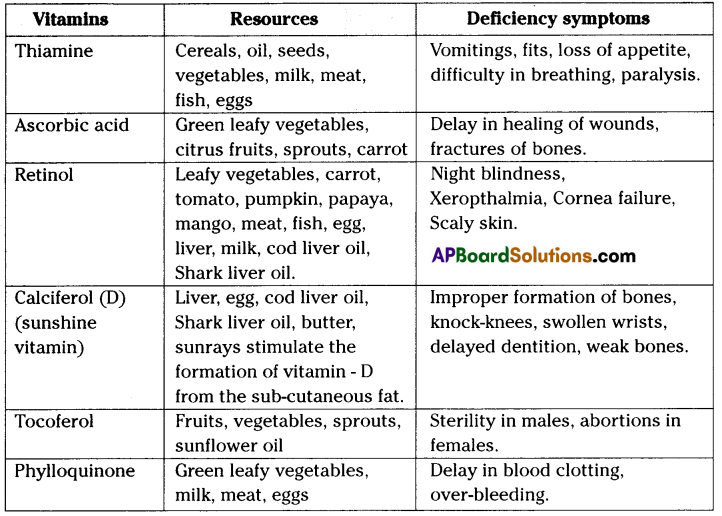
i. Which vitamins deficiency causes diseases related to bones?
ii. Which vitamins we get by eating fruits?
iii. Which vitamin deficiency causes Paralysis? To prevent it, what type of food we have to eat?
iv. To avoid vitamin deficiency diseases, what type of food we have to eat?
Answer:
i. Calcifero! – Vitamin – D. deficiency causes diseases related to bones.
ii. Retinol – Vitamin – A, and Tocoferol – Vitamin – E we get them by eating fruits.
iii. Paralysis is caused by the Vitamin (B1) Thiamine deficiency.
To prevent this disease, we have to eat cereals, oil seeds, vegetables, milk, meat, fish and eggs.
iv. To avoid vitamin deficiency diseases, we have to take proper diet. Our diet should be a balance one which contains proper amount of carbohydrates, proteins, vitamins, mineral salts and fats.
![]()
Question 2.
Write the mechanism of light dependent reactions in Photosynthesls.
Answer:
Light reaction takes place in grana thylakoids of chloroplast. The following events occurs in the light-dependent reaction.
- Step-i: The chlorophyll on exposure to light energy becomes activated by absorbing photons of light energy.
- Step-ii: The activated energy is used in splitting the water molecule into hydrogen (H+) and hydroxyl ion (OH–). This reaction is known as photolyses or Hill’s reaction. H2O → OH
- Step-iii : Water (H2O) and oxygen (O2) are produced by trie OH Eons through a series of reaction.
Step-iv: H ions are involved in the synthesis of ATP and NADPH which are the end products of light reaction. These are called assimilatory powers.
![]()
Question 3.
What are fat soluble vitamins? Explain the deficiency diseases due to deficiency of fat soluble vitamins and their symptoms
Answer:
Fat soluble vitamins:
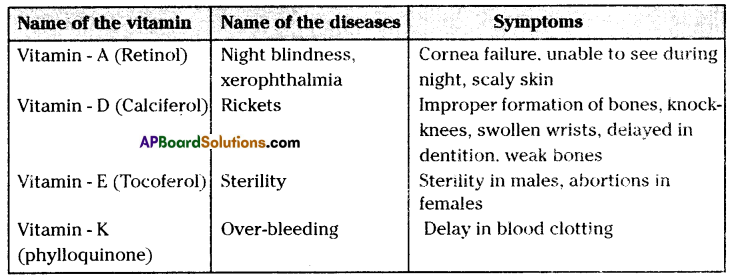
Question 4.
Read the table and answer the following questions.
Answer:
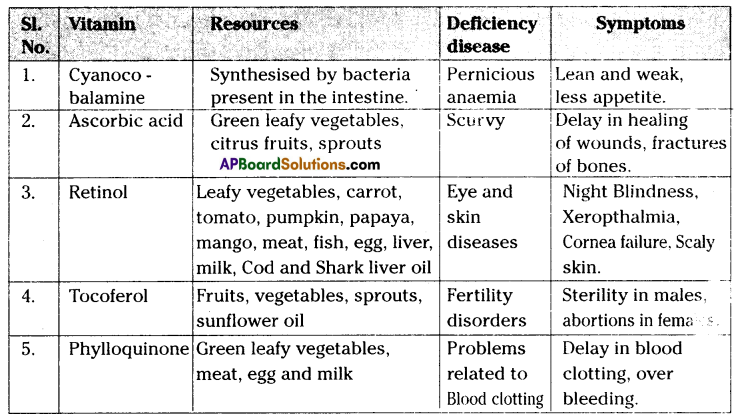
i. Name the anti-sterility vitamin from the above table.
Answer:
Tocoferol (Vitamin E) is the anti – sterility vitamin.
ii. Which vitamin deficiency that causes the gums bleeding?
Answer:
Ascorbic acid (Vitamin C) deficiency causes the gums bleeding.
iii. Name the fat soluble vitamins from the above.
Answer: Retinol (Vitamin A), Tocoferol (Vitamin E)) Phylloquinone Vitamn are the fat soluble vitamins.
iv. Name the symptoms that appear due to deficiency of vitamin K.
Answer:
Delay in blood clotting, over bleeding are the symptoms appear due to deficiency of vitamin K.
![]()
Question 5.
Mention different modes of nutrition. Explain the mode of nutrition In Cuscuta.
Answer:
There are different modes of nutrition.

Parasitic Nutrition in Cuscuta:
- Cuscuta plant is the best example for parasitic nutrition.
- It contains no chlorophyll and has root like structures called haustoria.
- With the help of haustoria, cuscuta absorbs nutrients from it’s host plant.
- As cuscuta grows on the host plants, its roots gradually degenerated and it establishes firmly on the host plant.
- Meanwhile, the root rots away after stem contact has been made with a host plant.
- As dodder grows, it sends out new haustoria and establishes itself very firmly on the host plant.
- After growing in a few spirals around one host shoot, the dodder linds its way to another.
- It continues to twine and branch until it resembles a fine (lensley tangled web of thin sterns enveloping the host plant.
Question 6.
Do the malnutrition reason for diseases? Why? Write any of such disease and its characters.
Answer:
Yes, malnutrition is the reason for occurrance of diseases. Malnutrition is eating of food that does not have one or more than one nutrients in required amount. This result in scarcity of nutrients for the proper growth and health of the individual. Kwashiorkor disease occurs in children due to the (leficiency of proteins in the diet.
Characteristic features of Kwashlorkor disease:
- Body parts becomes swollen due to accumulation of water in the intercellular spaces.
- Very poor muscle development, swollen legs, fluffy face, difficult to eat, diarrhoea, dry skin are the symptoms of Kwashiorkor disease.
- The child becomes lethargic and shows little interest in its surroundings or in playing and learning.
| S. No. | Vitamin | Deficiency diseases |
| 1. | Thiamine (B1) | Beriberi |
| 2. | Riboflavin (B2) | Glossitis |
| 3. | Niacin (B3) | Pellagra |
| 4. | Pyridoxine (B6) | Anaemia |
| 5. | Cyanocobalamine (B12) | Pernicious anaemia |
| 6. | Folic acid (B9) | Anaemia |
| 7. | Pantothenic acid | Burning feet |
| 8. | Biotin | Nerves disorders |
| 9. | Ascorbic acid (Vitamin C) | Scurvy |
| 10. | Retinol (Vitamin A) | Eye and Skin diseases – Night blindness, Xerophthalmia, Rupture of cornea, Scale formation on skin |
| 11. | Calciferol (Vitamin D) | Rickets, fragile bone |
| 12. | Tocoferol (Vitamin E) | Fertility disorders – Sterility in males,Abortions in females |
| 13. | Phylloquinone (Vitamin K) | Blood clotting |
Question 7.
Briefly explain about autotrophic nutrition.
OR
How green plant get their food?
Answer:
- Autotrophic nutrition is that mode of nutrition in which organism makes its OWfl food from the simple inorganic materials like carbon dioxide and water in the presence of sunlight.
- In autotrophic nutrition, organic material is prepared from inorganic materials.
- The green plants have an autotrophic mode of nutrition. The autotrophic bacteria also obtain their food by the autotrophic mode of nutrition.
- Autotrophs are the organisms that can prepare their own food materials.
- The autotrophic organisms contain green pigment called chlorophyll which is capable of trapping sunlight energy.
Question 8.
What is light reaction ? What are the steps involved in it?
OR
Explain the process of light dependent reaction.
Answer:
- Reaction of photosynthesis that takes place in presence of light are called light reactions or photocheinical reactions.
- The light reaction takes place in chlorophyll containing thylakoids called grana of chloroplasts.
- Step – I: Light reaction occurs in several steps. In the first step, the chlorophyll on exposure to light energy becomes activated by absorbing photons. (Photon is a unit of light energy)
- Step – II: In the second step, the energy is used in splitting the water molecule to release O2.
The reaction is known as photolysis (photo means light, lysis means breaking).
This was discovered by Robert Hill. Hence it is called Hills reaction. - Hydrogen produced in photolysis is immediately picked up by special compound NADP (Nicotinamide Adenine dinucleotide Phosphate) to form NADPH (Reduced NADP).
- Another energy-rich comp( ‘und AFP(Adenosine triphosphate) is also formed at the end of the light reaction.
![]()
Question 9.
Explain the dark reaction of photosynthesis.
OR
Explain the light-independent reaction.
Answer:
- Light-independent reaction do not require light energy and occur simultaneously with light reaction.
- This is also called dark reaction. But the term (lark reaction does not mean that it occurs when it is dark at night.
- Dark reaction occur in the stroma region of chloroplast.
- H+ ions produced in photolysis are immediately picked up by special compound NADP to form NADPH.
- In the dark Phase, the hydrogen of the NADPH is used to combine it with CO2, by utilizing ATP energy and to ultimately produce glucose (C6H12O6).
- This synthesis occurs in a number of steps using certain special intermediate compounds (mainly Rihulose bi phosphate) and enzymes.
- Finally glucose converted into starch.
Question 10.
Describe the digestion of food in the stomach.
OR
What are enzyina tic actions on food in stomach?
OR
What changes does food undergo in stomach?
Answer:

- The stomach is a large organ which expands when food enters it.
- The muscular walls of the stomach help in mixing the food thoroughly with more digestive juices.
- The gastric glands present in the wall of the stomach secrete gastric juice which contains hydrochloric acid, pepsin and mucus.
- The hydrochloric acid facilitates the action of the enzyme pepsin and also kills the germs present in the food.
- The enzyme pepsin digests proteins and mucus protects the inner lining of the stomach from the action of the acid under normal conditions.
![]()
Question 11.
Write about the parasitic nutrition in cuscuta plant.
Answer:
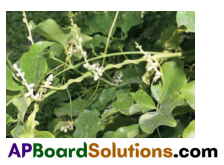
- Dodder (genus cuscuta) is a leafless, twining, parasitic plant belongs to family convolvulaceae.
- The dodder contains no chlorophyll.
- Cuscuta reflexa has been found to have very little amount of chlorophyll hence it absorbs food through haustoria.
- Haustoria are root like structures that penetrate the tissue of a host plant and may kill it.
- The dodder’s seed germinates, forming an anchoring root, and then sends up a slender stem that grows in a spiral fashion until it reaches a host plant.
- It then twines around the stem of the host plant and throws out haustoria, which penetrate it.
- Water is drawn through the haustoria from the host plant’s stem and xylem, and nutrients are drawn from its phloem.
Question 12.
Write about the digestion of food in the small intestine.
OR
In small intestine how carbohydrates, proteins and fats, are digested ? Name different enzymes which help in digestion in small intestine.
Answer:
- The small intestine is the longest part of the alimentary canal.
- It is the site of the complete digestion of carbohydrates, proteins and fats.
- It receives the secretion of liver and pancreas for this purpose.
- These juices make the internal condition of the intestine gradually to a basic or alkaline one.
- Bile juice secreted by liver breaks down fats into small globules like forms. This process is called emulsification.
- Pancreatic juice contains enzymes like trypsin for carrying on the process of digestion of proteins and lipase for fats.
- Walls of the small intestine secrete intestinal juice. This is also known as succus entericus.
- The intestinal juice consists of enzymes like enterokinase, peptidase, lipase, sucrase, nucleotidase, nucleosidase etc.
- Enzymes present in the intestine completely digest the partially digested food.
- Following digestive processes take place in the intestine.
a. Peptidases convert peptides into amino acids.
b. Intestinal lipase completely digest fats into fatty acids and glycerol.
c. Enzymes sucrase, maltase, lactase hydrolyses, sucrose, maltose and lactose respectively converting them into glucose.
d. Nucleotidase and nucleosidase complete the digestion of nucleic acids. - The end products of digestion are absorbed in the intestine.
Question 13.
What are the health aspects of the alimentary canal?
OR
What are the reasons for vomitings? How our digestive system get rid of unwanted substances?
Answer:
- The human alimentary canal usually functions remarkably well considering how badly we treat it on occasions.
- Vomiting is the bodys method of ridding itself unwanted or harmful substances from the stomach.
- There are many causes of vomiting, but one of the most common is over eating,especially when the food contains a high proportion of fat.
- The liver is unable to cope with the excessive fat and we get a feeling of nausea and sometime headache.
- Indigestion is a general term used when there is difficulty in digesting food.
- A more serious form of indigestion is caused by stomach and duodenal ulcers. These conditions occur more often in people who may be described as hurried or worried.
- Those who are able to relax, who are not continually tensed up, and who live at a slower pace, seldom get ulcers.
- For good health it is necessary to empty the bowels regularly.
- If the food residues remain in the colon for too long, the bacteria present have more time to produce harmful substances which may be absorbed by the blood.
- Constipation can often be avoided by having plenty of roughage in the diet.
Question 14.
Write the mechanism of photosynthesis in plants.
OR
How starch is formed from CO2, sunlight and water in green plants?
Answer:
- There are two major phases found in photosynthesis. They are light reaction and dark reaction.
- The light reaction takes place in chlorophyll containing thylakoids called grana of chloroplasts.
- The chlorophyll on exposure to light energy becomes activated by absorbing photons.
- The energy is used in splitting the water molecule into its two component ions.
H2O → H++OH–
This is known as photolysis of water. - OH– ions through a series of steps produce water and oxygen.
- ATP and NADPH are formed at the end of the light reaction are called assimilatory powers.
- Dark reactions do not depend on light. These reactions occur in stroma of chloroplast.
- W ions produced in photolysis are immediately picked up by special compound NADP to form NADPH.
- In the dark phase, the hydrogen of the NADPH is used to combine it with CO2 by utilising ATP energy and to ultimately produce glucose.
- The synthesis of glucose occurs in number of steps using certain special intermediate compounds (mainly ribulose biphosphate) and enzymes.
- Finally the glucose is converted to starch.
Question 15.
Briefly describe the digestion of food materials in alimentary canal with the help of a diagram.
Answer:


1. Human digestive system is very complex in nature where different parts are involved and perform different functions by using various digestive juices and enzymes.
2. The alimentary canal is basically a long tube extending from the mouth to the antis.
![]()
3. The process of taking food in the body is called ingestion.
4. Food is masticated by our teeth in the mouth and mixed with saliva to make it slippery and wet.
5. Salivary glands secrete saliva which contains amylase that helps in the breakdown of carbohydrates into simple ones.
6. The tongue helps in mixing the food and pushing it into the next part called oesophagus.
7. The soft food mixed with saliva passes through oesophagus or food pipe by wave like movements called peristaltic movernents to the stomach.
8. The gastric glands in the stomach secrete gastric juice that contains hydrochloric acid, protein digesting enzyme pepsin and mucus.
9. Partially digested food chyme is released in small amounts by sphincter muscles reach small intestine.
10. Bile juice secreted by liver and pancreatic juice secreted by pancreas release into the duodenum of small intestine.
11. Emulsification of fats is done l)y bile juice. Pancreatic juice contains enzyme trypsin for carrying on the process of digestion of proteins and lipase for fats.
12. Complete digestion of carbohydrates, fats and proteins takes ilace in the small intestine by intestinal juice.
13. Finger-like projections present in the walls of small intestine are called villi. They absorb the digested food into the blood.
14. Rest of the food is sent into the large intestine where most of the water present in it is absorbed from the food.
15. This material is then expelled through the anus which is the last part of the alimentary canal.
![]()
Question 16.
Differentiate between the nutrition process of plants and animals.
Answer:
1. Plants make their own food while animals have to rely on plants or other animals for food.
2. In photosynthesis plant converts carbon dioxide and water in the presence of light energy and chlorophyll to glucose. water and oxygen.
3. Hence the end products of plant nutrition are actually glucose and oxygen.
4. On the other hand, in animal nutrition, large food molecules are broken down into smaller soluble molecules.
5. In humans proteins are broken down into amino acids, carbohydrates are broken down into glucose, fructose and galactose while fats are broken down into fatty acids and glycerol.
6. Thus the end products of animal/human nutrition are amino acids, simple sugars/monosaccharides, fatty acids and glycerol.
7. The features/organs involved in the nutrition in plants are also different from that in animals.
8. In plant nutrition leaf plays an important role. Petiole, lamina, upper and lower epidermis, chloroplasts and mesophyll tissues are also essential in plant nutrition.
9. In contrast organs involved in animal/human nutrition include the mouth, buccal cavity, oesophagus, stomach, small intestine and large intestine.
Question 17.
List out the organs/systems involved in the process of digestion and explain briefly their function.
Answer:
Organs/Systems involved in the process of digestion are mouth, oesophagus, stomach, small intestine, pancreas, liver, gall bladder, large intestine and anus.
Mouth : Digestion of food begins in the mouth. Chewing breaks the food into pieces that are more easily digested. Saliva helps in breaking down complex molecules of food.
Oesophagus: By means of peristalsis the oesophagus delivers food to the stomach.
Stomach : in the stomach gastric juice secreted by gastric glands contains HCl, pepsin and mucus. HCl kills bacteria in the food, pepsin digests proteins and mucus protects the inner lining of the stomach from the corrosive action of HCl.
Small intestine:
- Bile juice secreted by liver releases into small intestine, It breaks down large fat molecules into smaller globules by a process called emulsification.
- Pancreatic juice released by pancreas is also released into the small intestine. Pancreatic juice contains amylase, trypsin and lipase.
- Amylase converts carbohydrates to glucose. Trypsin converts proteins to amino acids. Lipase converts fats into fatty acids and glycerol.
- Gall bladder stores and concentrates bile and then releases it into the duodenum to help absorb and digest fats.
Large intestine:
- Absorbs water from undigested food, producing faeces.
- Faecal matter is temporarily stored in the rectum of the large intestine.
Anus: Undigested food material is sent out of the body through anus.
II. Asking Questions and Making Hypothesis
Question 1.
If you have chance to meet any doctor (physician) or nutritionist, what questions you will ask about the health of alimentary canal (digestive system)?
Answer:
I will ask the following questions about health of alimentary canal.
- What is vomiting ?
- What are the reasons for vomiting?
- What is the reason for constipation?
- Why we feel nausea and headache?
- Why some people suffer from ulcer?
- What kind of food should be taken by the people suffering from ulcers?
- Why shouldn’t eat junk food?
………………. (You can add some more questions based on concept).
![]()
Question 2.
Imagine what happens if saliva not secrets into mouth cavity.
Answer:
- If saliva not secrets into mouth cavity, taste of the food may not be known.
- It is difficult to swallow the food.
- Digestion of carbohydrates may not start, as ptyaline may not add to food.
Question 3.
What did Priestly hypothesize on the experiment he conducted on the role of air in the growth of plants?
Answer:
Priestly hypothesized that plants restore to the air whatever breathing animals and burning candles remove.
III. Experimentation and Field Investigation
Question 1.
Describe an experiment conducted by Von Helmont that water was essential for the increase of plant mass.
Answer:
1. A Belgian scientist Jan Baptist Von Heimont (1648) conducted an experiment that continued for five years.
2. Von Helmont took a small willow tree and planted it in a large pot with soil.
3. Before he did this, he carefully measured the mass of the dry soil and mass of the tree.
4. He covered the soil with a lid so that nothing could fall onto the surface of the soil and add to its mass.
5. There were holes in the lid so that the tree could grow out of the soil and that air and water could reach the roots.
6. Von Heirnont left the tree for five years, giving it only rain water to drink.
7. At the end of five years he measured the mass of the tree and the mass of the dry soil for a second time.
8. The results of this experiment are shown below.
| At start | After five years | Change in mass (Kg) | |
| Tree | 2.27 | 76.74 | 74.47 |
| Dry soil | 90.72 | 90.66 | 0.06 |
9. This experiment changed the belief of hundreds of years. This is because Von
Helmont arrived at a result that
a. The substances needed for the growth of a plant do not come from the soil only.
b. The plant grow because of the water it gets.
Question 2.
Answer the following questions by observing the diagram showing the experiment:
a. What will you prove by this experiment?
b. What apparatus do you use In this experiment?
c. What would be the results If the experiment is done in shadow?
d. What will you do to obtain resist from the experiment?
Answer:
a. By this experiment we will going to prove oxygen is released during photosynthesis
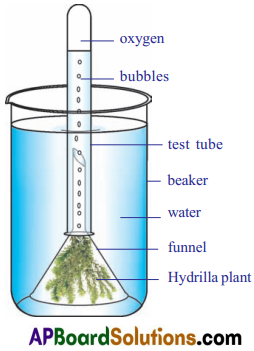
b.
- Beaker
- Test-tube
- Funnel
- Hydrilla Plant
- Burning splinter.
c. If we conduct this experiment in shadow, no change in the water level of the test- tube. No photosynthesis occurs. No air bubbles are formed.
d. If the burning splinter is kept near the mouth of test tube, it burns brightly.
![]()
Question 3.
Describe an experiment conducted by Joseph Priestly which revealed the essential role of air in the growth of green plants.
Answer:
1. Joseph Priestly in 1770 performed a series of experiments that revealed the essential role of air in the growth of green plants.
2. Priestly discovered oxygen in 1774.
3. Priestly observed that a candle burning in a closed space, a bell jar, soon gets extinguished.
4. Similarly, a mouse would soon suffocate in a closed space of the hell jar.
5. He concluded that a burning candle or an animal, both somehow, damage air.
6. But when he placed a mint plant in the same hell jars, he found that the mouse stayed alive and the candle when lighted from outside continued burning in the presence of the mint plant.
7. Priestly hypothesized as plants restore to the air whatever breathing animals and burning candles remove.

a. in the experiment to prove that starch is produced during photosynthesis. Why do we boil the leaf in alcohol?
Answer:
We boil the leaf in alcohol to remove all the chlorophyll from the leaf.
b. In the experiment to show that sunlight is necessary for photosynthesis. Why do we immerse leaf in boiling water?
Answer:
Immersing leaf in boiling water will breakdown the cell membranes of leaf cells and make the leaf more permeable to iodine solution, so that it can reach the starch present inside the leaf cells.
c. Why do we have to destarch the leaf before conducting experiment on photosynthesis?
Answer:
This is because chlorophyll interferes in the test for starch due to its green colour.
d. Why is a water bath used for heating alcohol in which leaf is kept inside the beaker for testing tite presence of starch?
Answer:
A water bath is used here for heating alcohol because alcohol is a highly inflammable liquid. So if alcohol Is heated directly over a flame, then it will catch fire at once.
IV. Information skills and proiects
Question 1.
Write water soluble vitamins information, their resources, deficiency diseases and its symptoms in the form of a table.
OR
Give an account of water soluble vitamins, their occurrence, deficiency diseases and symptoms.
Answer:
Vitamins, available sources and deficiency diseases:
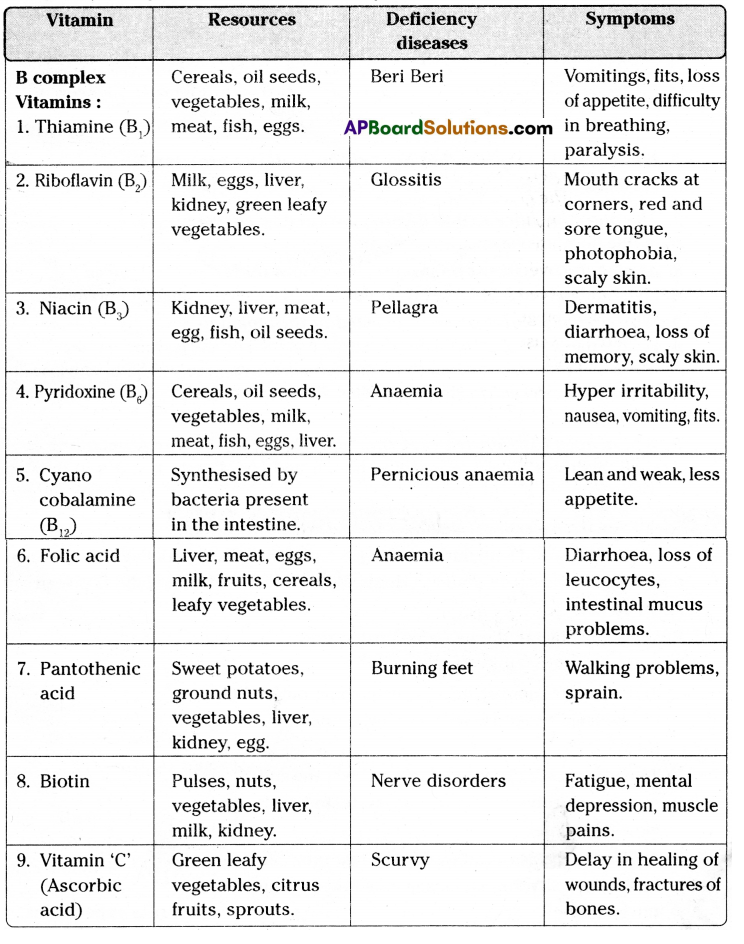
Question 2.
Observe the following information and answer the following questions.
Answer:
Some enzymes and juices of gut
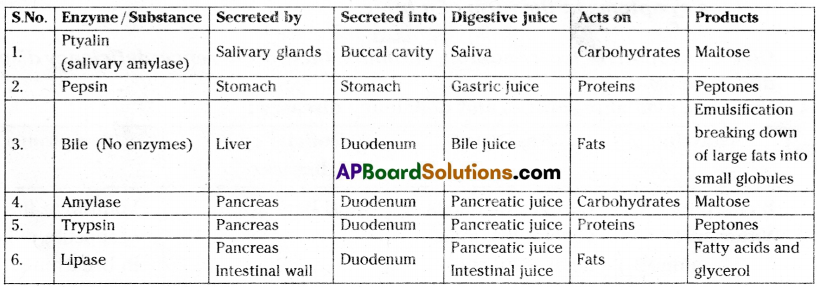
1. What are the enzymes that are helpful to digest proteins?
Answer:
Enzymes that are helpful in digestion of proteins are pepsin and trypsin.
2. The digestive juice which do not contain any enzyme?
Answer:
In Bile juice no enzymes are present.
3. At which place liver and pancreas secretes their digestive juices?
Answer:
Liver and pancreas secretes their digestive juices at ‘U shaped duodenum.
![]()
4. Why carbohydrates are not digested in the stomach?
Answer:
For the digestion of carbohydrates, enzyme ptyalin or amylase are required. The gastric juice produced by stomach do not contain the enzyme ptyalin or amylase. It contains only pepsin which digests proteins. Hence carbohydrates are not digested in the stomach.
5. Where does carbohydrates & fats digestion starts in our Alimentary canal?
Answer:
Carbohydrates digestion starts in mouth and fats digestion starts in duodenum with mixing of Bile juice.
V. Communication Throught Drawing, Model Making.
Question 1.
Draw the diagram of equipments arrangement in Hydrilla experiment. You did to prove that oxygen releases in photosynthesis. Write reasons why test tube is placed upside down on funnel.
Answer:
Reasons for placing the test tube upside down on funnel:

- To count the number of bubbles coming out of the hydrilla twigs per minute during photosynthesis.
- To collect sufficient amount of oxygen at the end of the test tube so that it can be tested with glowing splinter.
- Amount of oxygen produced in the test tube can be measured by the displacement of water within the test tube.
Question 2.
Test the nature of food in mouth by Litmus paper.
Answer:
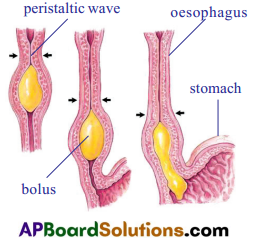
- Before taking food into the mouth, take a litmus indicator paper and touch it to the tongue.
- We observe no colour change.
- Perform the litmus test again after chewing the food and swallowing it.
- The litmus indicator paper turns blue colour.
- This demonstrates that amylase converts complex carbohydrates to simple sugar. Amylase is alkaline in nature. This turns litmus paper blue when touches glucose at the second time.
Question 3.
Draw flow chart of human digestive system.
Answer:

Question 4.
Draw a neat labelled diagram of T.S. of leaf. What is the function of stomata?
Answer:
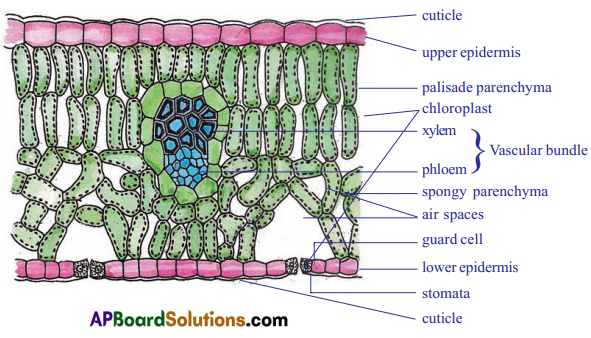
The function of stomata is to exchange of gases.
Question 5.
Deekshith conducted an experiment that presence of starch in leaves. Draw a diagram for this experiment.
Answer:

VI. Appreciation and Aesthetic Sences, Values
Question 1.
Which issues do you take into consideration to tell that plants play a key role in animals nutrition?
Answer:
1. Plants play a very important role in nutrition of animals. Actually plants are the producers whereas animals are dependent on plants for their nutrition.
2. Many plants or plants parts are eaters as food. There are around 2000 plant species which are cultivated for food. Nutrients like carbohydrates, proteins, fats, vitamins and minerals are available from these plants.
3. Seeds of plants are good sources of food for animals including humans because they contain many healthful fats.
4. Infact majority of the food consumed by human beings are seed based food. Edible seeds include cereals liks wheat, rice, maize etc. and legumes like pea, groundnut and nuts.
5. Oil seeds are often pressed to produce rich oils like sunflower, groundnut, sesame etc.
6. Seeds are typically high in unsaturated fats and considered as a health food.
7. Fruits are the ripened ovaries of Plants including the seeds within. Many plants and animals have coevolved such that the fruits of the former are an attractive food source to the later.
8. Vegetables are a second type of plant matter that is commonly eaten as food.
9. Hence all the nutrients required by animals are available to the animals from plants. Hence plants are playing an important role in nutrition of animals including human beings.
Question 2.
How will you appreciate role of tongue?
Answer:
In human buccal cavity food is chewed well with the help of tongue and tooth. Taste of the food knows through tongue only.
VII. Application to Daily life, Concern to Biodiversity
Question 1.
We know that by taking different types of food materials we will get vitamins. For this what changes shall we lake in our food habits?
Answer:
- Eating of rice polished only for one time gives us vitamin thiamine in abundant amount.
- We should eat the balanced food containing nutrients in equal quantities.
- Fresh leafy vegetables are rich source of vitamins Riboflavin, Folic acid and Vitamin ‘C’. So our diet should contain these leafy vegetables.
- Sufficient amount of non-vegetarian foods like meat, poultry, fish, kidney and liver should present in our food.
- Eating fresh fruits also add number of vitamins to our body.
- Whole cereals like wheat, rice provide number of vitamins to our body. So we shall eat required quantities of cereals in our food.
Question 2.
Describe what disaster occurs on earth, if photosynthesis life process stops.
Answer:
1. If photosynthesis by plants stops, food will not be available to all other living organisms. Because all these organisms cannot prepare their own food material. Hence heterotrophy dies due to lack of food.
2. Carbondioxide is required for the process of photosynthesis by plants. If it stops the concentration of CO2 increases In the air that leads to an increase in the temperatures of the earth. If the temperature increases it causes global warming which causes melting of ice. This results in increase in sea levels and water inundates the low lying areas near the sea coast. So all the low-lying areas drown leading to the death of many organisms.
![]()
3. Photosynthesis releases oxygen into atmosphere. If photosynthesis does not occur the oxygen may not be available for the living organisms. This leads to death of living organisms.
Question 3.
How our digestive system get rid off spoiled food or poisoned food?
Answer:
Whenever we eat poisoned food (or) spoiled food, our digestive system can’t tolerate it and send out in form of vomiting, where stomach and oesophagus reverse their normal direction and food is expelled.
Question 4.
What precautions should be fake person suffering from obesity?
Answer:
Obesity is due to over eating and intake of excess of energy. It is big health hazard. The obese people should take following precautions.
- People should take low calorie food.
- They should eat limited or less food.
- They should avoid eating junk food.
- Do exercise regularly.
- Balance energy intake means eat according to their mode of work.